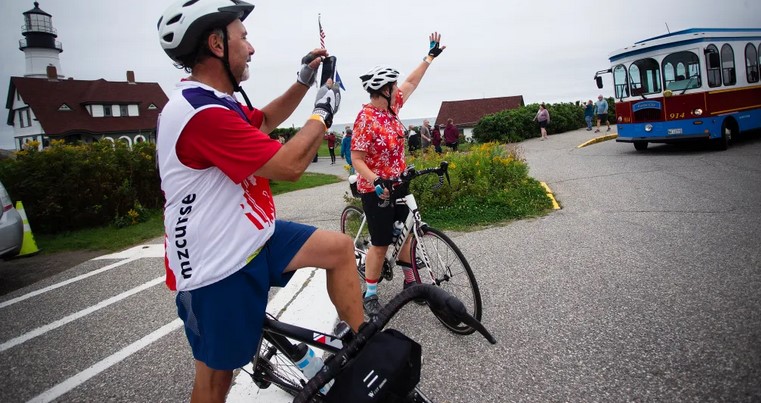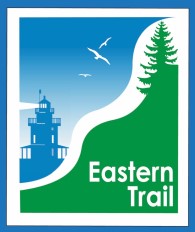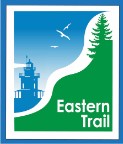
Nearly 800 riders took part in the 20th annual ride along the southern Maine coast, with registrations benefiting the Eastern Trail Alliance.
By Luna Soley | Times Record
SOUTH PORTLAND — There were sheer curtains of fog drawn across the bay, the sort of morning that makes you want to stay in bed. Not so for the riders gathered by Spring Point Light, chatting, adjusting helmets, and hailing friends as they waited for the go-ahead at 7 a.m. last Sunday to begin the 20th annual Maine Lighthouse Ride.
“We’re going to go off in groups of 50,” a volunteer instructed by megaphone. “Don’t be shy, feel free to come right up.”
Nearly 800 bicyclists took part in the event – coming from as far as Ontario and ranging in age from 7 to 89 – to ride routes of 25, 40, 62 or 100 miles along the southern Maine coast. About half of the riders were from Maine.
There was a sense of camaraderie. Leah Day of Peaks Island, seemed to speak for many riders when she said, “There’s no better way to spend the day than doing the Maine Lighthouse Ride!”
Day is the owner of Lighthouse Bikes in South Portland. She left a 25-year career in counseling to start the company after riding cross country with her son in 2019, when he was in high school. She did the 100-mile ride Sunday with a group of women from Peaks Island, one of whom said she hadn’t ridden that far since before her children were born.
The Maine Lighthouse Ride is an annual fundraiser to support the Eastern Trail Alliance, a nonprofit founded in 1998 with the aim of turning sections of the old Eastern Railroad Corridor into a continuous route for bikers and hikers. The Eastern Trail now covers approximately 65 miles, from the Piscataqua River in Kittery to South Portland.
The fundraiser is generated by registration fees, which ranged from $115 for the 25-mile ride to $140 for the 100-miler, or century ride as it is called. Bob Bowker, the ride’s founder, said proceeds from this year’s ride will go toward maintaining the route, improving kiosks and paying staff.
Participation in the event has grown dramatically since the inaugural ride in 2003, held as a 40-mile route by 40 determined riders in the rain.
“We were actually following the riders around with hot coffee and hot soup,” Bowker said. After four or five years, “We were up to 300 or 400 riders,” he added. “It was mostly word of mouth, it just kept growing and growing.”
The Eastern Trail has added 11 miles of off-road trail to its network since 2008. Still, there is a long way to go to complete the alliance’s ambitious vision of connecting Kittery to South Portland with a continuous off-road trail. The campaign to “Close the Gap” with a 1.6-mile connector trail between South Portland and Scarborough has taken longer than anticipated. The alliance has received funding and approval for the project, but officials don’t anticipate breaking ground until early next year.
However, Bob Hamblen, vice president of the board of the Eastern Trail Alliance and former city planner in Saco, said he feels “more positive than ever” about the progress of the trail. “We may be in a bit of a holding pattern for the Close the Gap project, but we know that that will be brought to a conclusion in the relatively near future.”
The bicyclists riding in support of the alliance went off in half-hour intervals on Sunday, depending on the length of their routes, with the century riders leaving first at 7 o’clock.
When asked whether he was nervous before the century start, Doug Brockelbank replied, “No, no I love it.” Then he paused for a few moments, unsure if he heard the question correctly. “At risk? Is that what you said? No, I’m excited.”
His friend interjected. “He’s definitely at risk,” he said, laughing.
Less than 5 minutes later, their jersey-clad backs, hunched over their bikes at a matching angle, disappeared around the first turn.
Despite winding roads through Cape Elizabeth, frequent spurs suddenly leading to an open coast, and the not-so-welcome interruption of 2 1/2 miles of gravel road across the Scarborough Marsh (repeated twice for riders doing 40, 62, and 100 miles), nobody seemed to lose their way. As promised, neon orange circles – with a line pointing in the direction of the next turn, were spray painted at frequent intervals along the route.
A rest stop at Cape Elizabeth’s Kettle Cove proved to be popular among the riders. Between predictable slices of watermelon and a heap of bananas, trays of pickles and a big bowl of chocolate peanut butter cups were disappearing at time-lapse speed. The contents of the trash can were flecked with gold foil. This was not a day to eat just one.
A mere 2 miles from the finish, riders climbed a steep hill and stopped to admire the view from Portland Head Light. “There’s a lot of interesting history and symbolism in these lighthouses,” said Reed Carlman, a senior at Bowdoin College, “but mostly I’m just glad to be along for the ride.”











